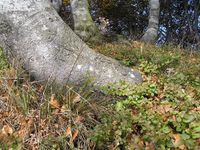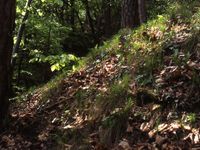List of species
bold
Dominant species, influencing the appearance of the habitat
 Character species
Character species
 Less strictly linked to a specific habitat
Less strictly linked to a specific habitat
| Scientific name | English name |  | Avenella flexuosa (L.) Drejer | Draht-Schmiele |  | Calamagrostis arundinacea (L.) Roth | Wald-Reitgras |  | Calamintha grandiflora (L.) Moench | Grossblütige Bergminze |  | Fagus sylvatica L. | Rot-Buche |  | Galium odoratum (L.) Scop. | Echter Waldmeister |  | Hieracium murorum aggr. | Wald-Habichtskraut |  | Ilex aquifolium L. | Stechpalme |  | Luzula luzuloides (Lam.) Dandy & Wilmott subsp. luzuloides | Gewöhnliche Weissliche Hainsimse |  | Luzula nivea (L.) DC. | Schneeweisse Hainsimse |  | Luzula sylvatica (Huds.) Gaudin | Gewöhnliche Wald-Hainsimse |  | Melampyrum pratense L. | Wiesen-Wachtelweizen |  | Monotropa hypophegea Wallr. | Kahler Fichtenspargel |  | Pinus sylvestris L. | Wald-Föhre |  | Prenanthes purpurea L. | Purpurlattich |  | Pteridium aquilinum (L.) Kuhn | Adlerfarn |  | Quercus petraea Liebl. | Trauben-Eiche |  | Vaccinium myrtillus L. | Heidelbeere |  | Veronica officinalis L. | Echter Ehrenpreis |
|---|
Status
Status according to the habitat priority list at the national level
| National Priority | K: no national priority |
| Need to take action | 0: mesures needed |
| International responsibility | K: none |
Status on national Red List 2016
IUCN status: Least concern

Additional information
IUCN criteria: --
- Legend
CO Collapsed CR Critically Endangered EN Endangered VU Vulnerable NT Near Threatened LC Least Concern
Regeneration status 2016
| Regeneration class | 6: more than 200 years |

